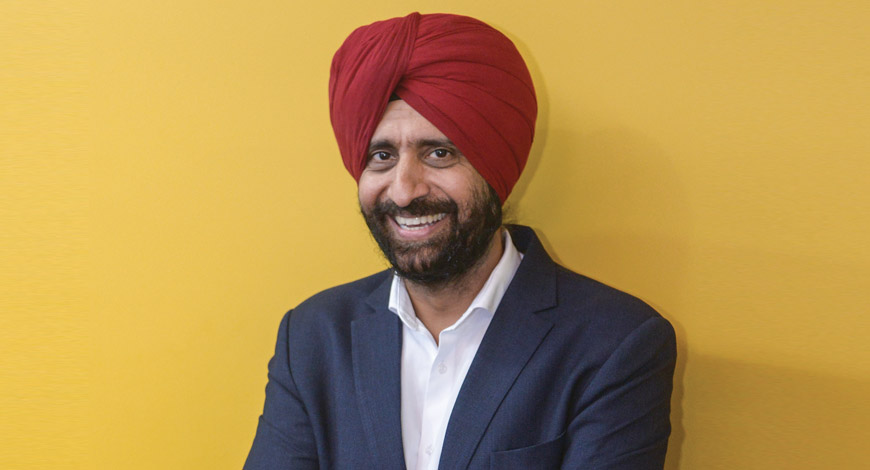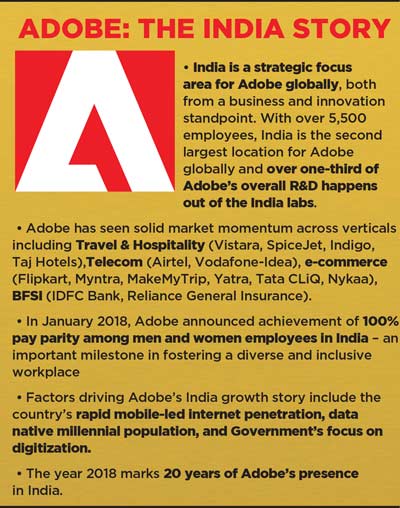 If Bawa has reinvented himself, so has Adobe, over the years. Throughout its history, Adobe has continued to innovate and adapt to market changes, to survive and grow. The computer software company’s foray into digital marketing as a business was a key part of its reinvention story and has played a strategic role in its solid growth over the last few years. In FY 2017 (ended December 1, 2017), Adobe earned global revenue of $7.3 billion. Out of this, Asia’s contribution was 15%, and within Asia, India is understood to have contributed a major share, though India revenue figures are not made public.
If Bawa has reinvented himself, so has Adobe, over the years. Throughout its history, Adobe has continued to innovate and adapt to market changes, to survive and grow. The computer software company’s foray into digital marketing as a business was a key part of its reinvention story and has played a strategic role in its solid growth over the last few years. In FY 2017 (ended December 1, 2017), Adobe earned global revenue of $7.3 billion. Out of this, Asia’s contribution was 15%, and within Asia, India is understood to have contributed a major share, though India revenue figures are not made public.At the heart of this growth story is Adobe’s belief that people do not buy products anymore, but invest in the ‘brand experience’.
INDIAN MARKETERS AND EXPERIENCE
“Life for you and me is very simple in the digital world. For everything we need, there is an app,” says Bawa. “But look at it from a brand’s perspective - it’s becoming more and more complex for them, because what consumers expect is very personalized messaging, a very personalized experience. So, if a Flipkart doesn’t show you something that is relevant for you, you would go one more click maximum, and then drop off and veer to Amazon or Shopclues or elsewhere. So, it’s becoming imperative for organizations, brands, companies to deliver personalized experiences for their customers in real time. In India, that story has really taken off in the last year. Initially, the online companies were our light house accounts, because of the nature of their business. But, we started seeing banks and insurance companies coming to us, then Telecom providers hopping on to the digital bandwagon. Today, we see everyone - from a tyre company to a cinema hall - saying that they need to transform digitally. Over the last year or so, the education companies came in looking to use Digital to gain competitive advantage and deliver a great experience. India is moving very quickly. And for Adobe, it’s a very fast growing market. I’m excited about the opportunity I see in India.”
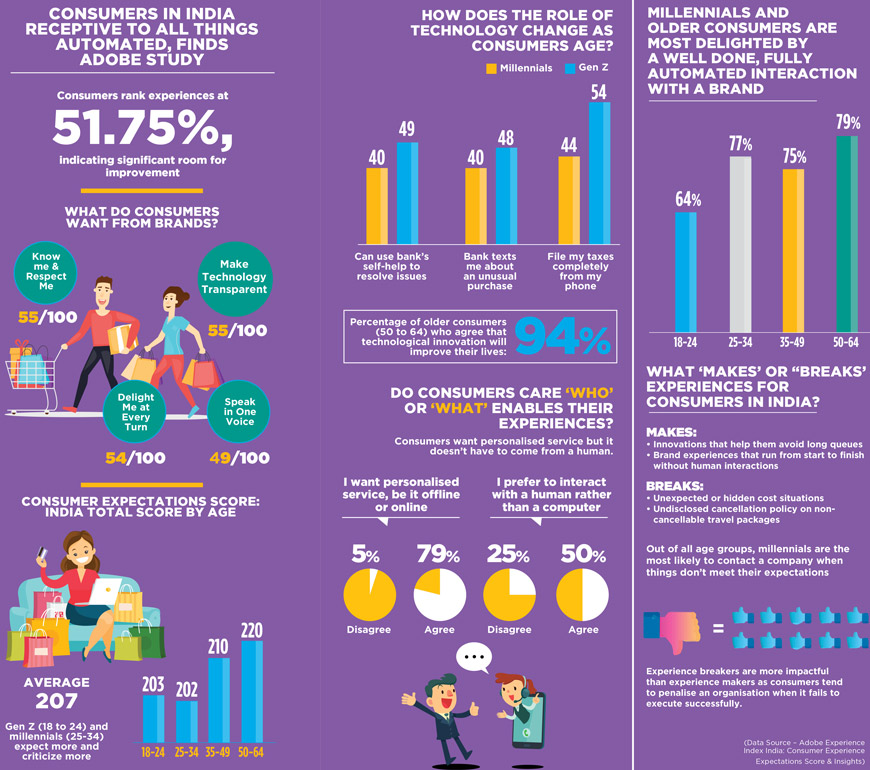
As of now, the new focus areas for Adobe in India remain the Government initiatives and Education. “Brick and mortar retail is another place that is coming up. And the BFSI segment, with the new start-ups, the fin-techs coming in, require focus,” Bawa adds.
WHAT DIFFERENTIATES INDIA AS A MARKET?
According to Bawa, what differentiates India and why energy levels and growth are so high, is - one, there is headroom for growth. Internet penetration is about 35% while in most mature markets today it is upwards of 80-85%. The second big reason is the whole Government thrust on Digital India. The third factor is that India is the oldest civilization but the youngest nation, because of the millennial population. “It is amazing to think where we would be in 2020, the kind of edge we would have over the rest of the world because of our young workforce and capacity to harness digital. And lastly of course is the mobile. So, we started off with saying that India is mobile first. And today it is a mobile only land. All of these things make India different, more vibrant, more energetic, more demanding,” says Bawa. “Looking at it from an Adobe perspective, India is an Android country. It forces organizations like us to get back to the drawing board to see how we can personalize our offerings more.”
India happens to be the second largest establishment for Adobe outside of North America. There are 5,500 people based out of India, out of a total workforce of 17,000. About 30% of the company’s R&D is based in India. A lot of Adobe’s cool products are actually touched upon in India, and intellectual properties created. The India business is one of the fastest growing. Any facet of Adobe is well represented in India, which is why it is a strategically important market.
Talking of the investments that Adobe is making in such a market, Bawa says, “We are hiring in India, we have been growing the numbers, and investments on all fronts. We just launched the artificial intelligence centre in Hyderabad. We have been growing our R&D for specifics that India may require, which is a big one for an American MNC to do. Investments are actually coming across the board, be it from a business front, or research front, or in the futuristic sense. For machine learning and artificial intelligence, or the lab in Hyderabad, or the global delivery center, we are pumping in money and resources into India.”
On the acquisitions front, the recent buyout of Magento commerce adds to the capabilities of Adobe, which is already into the e-commerce marketplace in a big way. In fact, four of the top five e-commerce players in India run on Adobe, end to end. “Magento is a great fit for this market. So, early days yet, but yes, we have already started the backend integration as well as the front end with customers,” says Bawa. Just last week, the company also acquired marketing automation company Marketo, and it is expected to widen Adobe’s lead in customer experience across B2C and B2B and put Adobe Experience Cloud at the heart of marketing.
BANKING ON THE ADVERTISING CLOUD
After the acquisition of ad-tech firm TubeMogul a couple of years back, Adobe’s ad-tech technologies became stronger. While it already had an efficient frontier in the Adobe media optimizer, largely for search, with the TubeMogul acquisition it became the Advertising Cloud, where everything from video to display to DSP, the entire gamut is available for customers to optimize their ad spends. “So, it’s a single stop. You don’t have to go to various agencies to manage manually a lot of the media spends,” says Bawa.
“The Advertising Cloud ensures bottomline saving. So, if you would spend ‘x’ today, you would spend ‘0.8x’ and get the same output. It’s very cost-effective in the sense that if you are saving money, you can then spend that money into target, personalization, building experiences for yourself.”
ADOBE SIGN: REDUCING PAPER IN THE SYSTEM
Just now, Adobe India is focusing on two things - one, ramping up the whole creative piece and creating a data platform. Second, it is investing in Sign, the electronic signature. “It’s not an easy battle to win,” says Bawa, talking of Sign. “We want to reduce paper-based inefficiency, but it’s slightly slow from an adoption viewpoint. We are looking at the Government and the banking sector, as well as the commerce engine where Sign could work better for us. But there’s still a long way to go.”
So how has been the uptake of Adobe Sign since its rollout? “We have taken it upon ourselves that we need to eradicate paper in the system and wipe out inefficiencies that exist in the world. All our music, all our video, the way we watch our movies, anything we look at is digitized. The one thing that’s not is paper documents and workflows. That’s the next big problem we are going to solve for the world. Our Document Cloud has the Adobe Sign. A few months back, we launched our data centre in India and integrated our Sign with Aadhar. We see Sign as the first layer of digitization. We are talking to large Government organizations, banking and financial services, HR, e-commerce companies that want to solve vendor inefficiencies. We have already got them hooked to the Adobe Sign,” Bawa says.
Meanwhile, Adobe has just signed an MOU with the Ministry of Skill Development and Entrepreneurship to train a million students under the Adobe Digital Disha Programme. It also announced that ‘Adobe Spark Premium’ – a story-telling Creative Cloud application - would be free for students and the youth.
WHY ONE SHOULD WORRY ABOUT THE SITUATION
Bawa says while Digital is growing in this country, and brands and businesses here are realizing that the only way they can differentiate themselves is through experiences, while there is a hunger that they need to hop on to the digital bandwagon, they are rehashing their strategies at a Board level. There is not enough ramp-up or skillsets being built fast enough, and that worries him. “If we can foster some digital literacy among millennials, it would be great. What worries me is are they understanding customer success? Are they getting it? The hunger is there, they know they need to do it. But, are they moving fast enough? Even for AI, how do you use it - how do you bring it in, are we weaving it in fast enough?” Bawa asks.
Looking ahead, Bawa says Adobe is well poised to take care of the Art and the Science - an optimization of the content and data in real time that actually helps businesses or brands deliver great experiences. “We can help businesses leapfrog very quickly because of the advantage we have on mobile and Digital. In the next one to five years, with advertising spends going up, with every single metric, and the GDP growth that we are seeing, it is going to be very promising for the country and promising for Adobe India.”
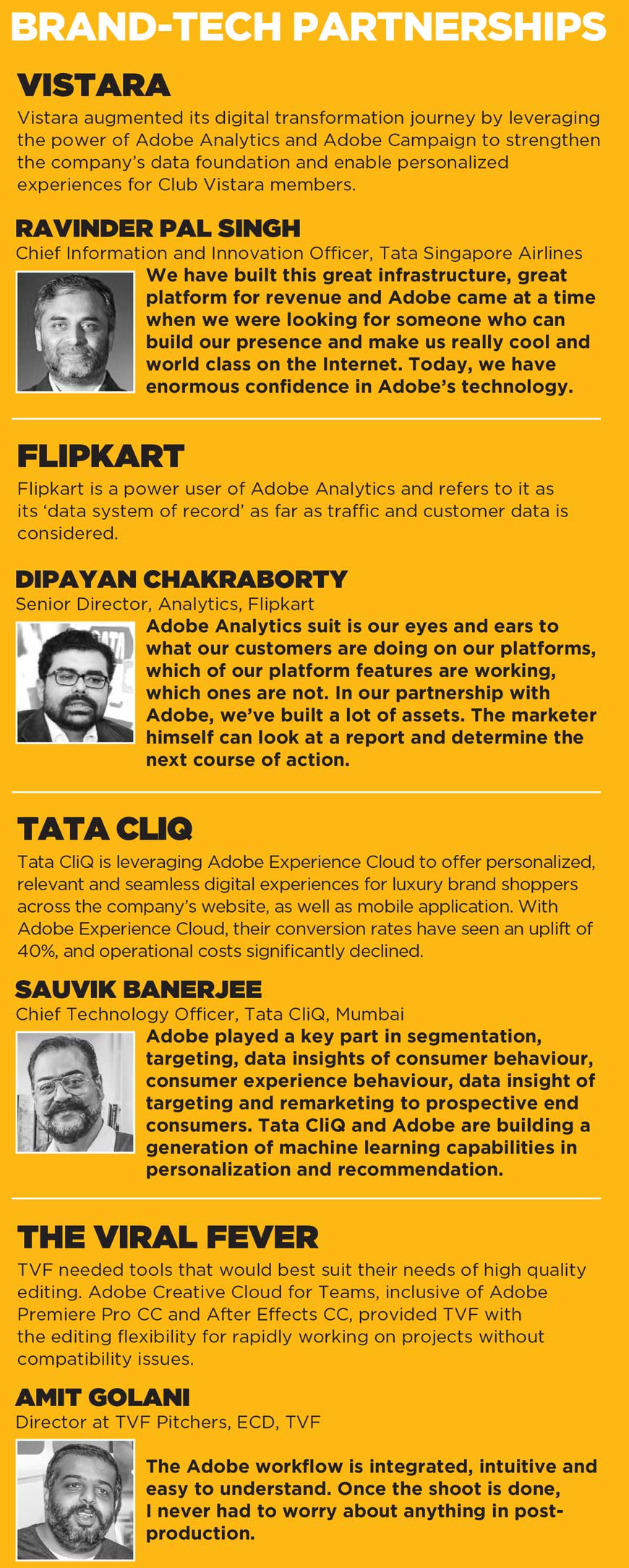
‘I LOOK FORWARD TO ‘WHAT’S NEXT’...’
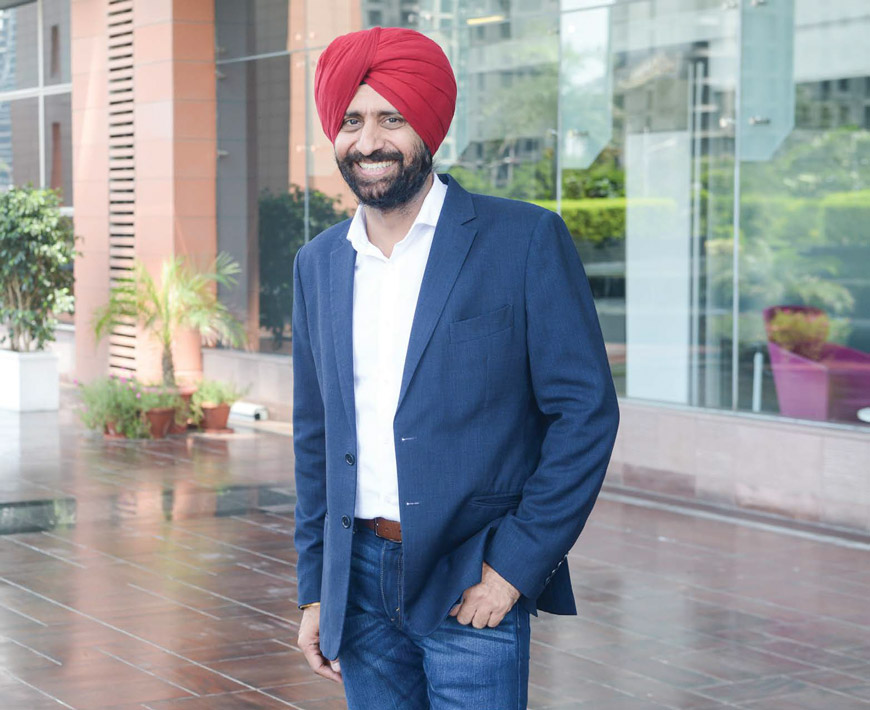
Q] What do you look forward to personally and professionally?
Personally and professionally - to me, it’s always one. I look forward to ‘what’s next’. I have always lived with an urgency all my life from the age of 10. There has to be an urgency and hunger. I am still battling myself on what next. What do you solve for the world? How do you leave a legacy which you have not cracked? I won’t like to go away without leaving a legacy that matters, that’s something that keeps me awake.
Q] Do you suffer from fear of missing out? Do you switch off work when at home?
If you enjoy what you are doing, you are always on. There is no on-off. So, it’s fun. I could be watching Netflix, and taking a call and solving a customer issue side by side. I could be waking up at 4 am or 3 am. I can sleep just four hours, and be good with it. About fear of missing out, I don’t know how much time I have, and there is so much to do. I get up early, go to my gym. I travel a lot with my daughters, with the family, every year, to new places we want to explore across the world. There is so much to do, and yes, it’s probably a fear of missing out before your time is up.
Q] How long does your typical day stretch?
About 18-20 hours. But, I have got all my medical parameters right. I keep getting a 10 on 10, and my wife hates it!
Q] If we ask you to describe yourself in one word, what would it be?
Integrity.
‘We’ve not even scratched 10% of the surface in each vertical in terms of digital transformation’
Sunder Madakshira, Head of Marketing, Adobe India, tells Srabana Lahiri that there is huge headroom for growth in the digital journey of brands, with AI, machine learning and other technologies adding momentum
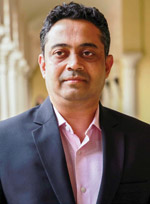 Sunder Madakshira, Head of Marketing for the India business at Adobe Systems Incorporated, is fond of telling a story from the early days of his marketing career, when he used to be an area sales manager for the Beverages Division of Hindustan Unilever. Tea shops used to be an important channel of distribution for the Beverages Division, and on a field visit to Madurai, he and the sales officer were trying to understand how the business was faring as market research had shown that they were at 95% of the market. “The sales officer would go behind each tea shop, talk to the shop owner and come back. On being asked why, he told me he went to look at the dustbin. Tea shop owners would claim they were using Hindustan Unilever tea, but the dustbins had plastic wrappers of competition cheap tea, or unbranded tea, meaning they were mixing those with our tea to cut cost. The dustbin was the true indicator of what the customers were actually using. I learnt that the share of dustbin is more important than the market-share numbers. It was a very big insight for me - if you don’t understand your customer, and how he is using your product, you will never be able to break through. In all my conversations today with customers, I and my team first ask what the customer wants,” says Madakshira, who works to grow the galaxy of brands moving towards digital transformation with the help of Adobe products .
Sunder Madakshira, Head of Marketing for the India business at Adobe Systems Incorporated, is fond of telling a story from the early days of his marketing career, when he used to be an area sales manager for the Beverages Division of Hindustan Unilever. Tea shops used to be an important channel of distribution for the Beverages Division, and on a field visit to Madurai, he and the sales officer were trying to understand how the business was faring as market research had shown that they were at 95% of the market. “The sales officer would go behind each tea shop, talk to the shop owner and come back. On being asked why, he told me he went to look at the dustbin. Tea shop owners would claim they were using Hindustan Unilever tea, but the dustbins had plastic wrappers of competition cheap tea, or unbranded tea, meaning they were mixing those with our tea to cut cost. The dustbin was the true indicator of what the customers were actually using. I learnt that the share of dustbin is more important than the market-share numbers. It was a very big insight for me - if you don’t understand your customer, and how he is using your product, you will never be able to break through. In all my conversations today with customers, I and my team first ask what the customer wants,” says Madakshira, who works to grow the galaxy of brands moving towards digital transformation with the help of Adobe products .Here are excerpts from a conversation with Madakshira, a seasoned marketer who has worked with brands like SAP, Wipro, Hindustan Unilever, VISA and EdgeVerve Systems (product subsidiary of Infosys) earlier in his career.
Q] From April 2017 when you joined Adobe to now, how do you see your progress in further enhancing brand Adobe and driving its growth in India?
It’s been a wonderful journey to see how we are trying to change our customers to own the digital marketing and digital media spaces. One of the things that Adobe is trying to impact is how we can get our customers to deliver very powerful experiences to their end consumers. The product, the service that you provide, all have to ultimately deliver completely differentiated and a wholesome experience that your consumers and customers just can’t forget. That makes them come back to the brand again and again. So, that’s been the core of whatever we have tried to do at Adobe, and I have seen a remarkable growth in terms of how we have been able to get our customers to deliver those experiences for their end consumers.
 Q] Could you quantify that growth rate in India?
Q] Could you quantify that growth rate in India?It would be safe to say that it has grown manifold.
Q] Going forward, where do you spot opportunity? Which are the next categories of brands that would be ready for digital transformation?
The opportunities we see are across verticals. Everybody is doing something or the other to get their customers to have a better digital experience. A few verticals are firing on all engines - one is the retail and e-commerce vertical, Telecom is another one, Travel and Hospitality, the BFSI sector, and of course the Government that has its own ways of adopting a lot of technology to enable citizen services and Tourism. While we have seen growth in all these areas, there is still a lot of work to be done, much higher scope. For example, if somebody is running their website very well on an Adobe system, they still have the opportunity to analyse data better using our Analytics solution, run their digital campaigns better. We have not even scratched 10% of the surface in the verticals. We still have a huge headroom for growth, with artificial intelligence and machine learning and other technologies coming in, and every quarter, we have some innovation that’s enriching the product.
Q] Marketing momentum has now moved to Tier II, Tier III cities and the big scope lies in the heart of India. So, how do you look at those geographies?
Many of our customers in India are B2C companies. In the last three to four years, they have made very specific attempts not to look at the metros or Tier I cities, but focus on Tier II, Tier III and even Tier IV cities. So, for example, Indigo Airlines is actually looking at penetrating the deepest parts of India, as is Airtel. We are helping them not just navigate the terrain in the metros, but also Tier III and Tier IV cities where local language is being adopted to communicate to the consumers. So, Indian companies and the Indian population are actually leapfrogging technology really well. People are accessing the Internet without necessarily going through a laptop or a desktop. They just use their phones. Our offerings - be it content or designing a website on a digital platform, then using analytics solutions or running a campaign - actually work across different languages because a lot of people don’t need to learn how to converse in English, but yet are using digital technologies to make seamless transactions. That’s an area we are very bullish about.
Q] What lies at the core of your partnership with brands? What are the three most important factors that Adobe would consider while planning or designing an experience for a brand? And what are the challenges you face?
Number one, what we are looking for is people who have clear growth ambitions, who want to grow, who want to look at new ways to grow. That’s very critical, because then we can customize our solutions to help them achieve that. The second thing is, we want them to be open to partnerships, open to recommendations, open to getting the best solutions for them in the world and partner with us for innovations. The third thing we look for is the pedigree of their own technology and how open they are to upgrade it. If they are open to adopting new technologies, that always works well for us because they can actually front-end with a lot more content, lot more information and subsequent technologies and platforms which will take them to the next level. The challenges are that people are not clear about what they actually want to achieve at the end of their digital journey. But in the last three or four years, there is lot more awareness in terms of what digital can do and need to integrate non-digital digital aspects through it, and how to leverage different types of technology. In India, people are not just looking at today when they buy technology, but whether it ready for tomorrow, and the day after, so that they don’t have to upgrade every 2-3 years.
Q] What is the outlook on Photoshop? Does it continue to be a flagship product for Adobe, and Illustrator as well?
Absolutely. So, that’s where we started - that is our creative bearing, and really our strength, because we don’t have any competition for those products. They continue to drive both the bottomline and topline for the company, and India is no exception. All of them are upgraded every three months. So, if you see Photoshop today, it’s hugely advanced compared to what it was even 18-20 months back.
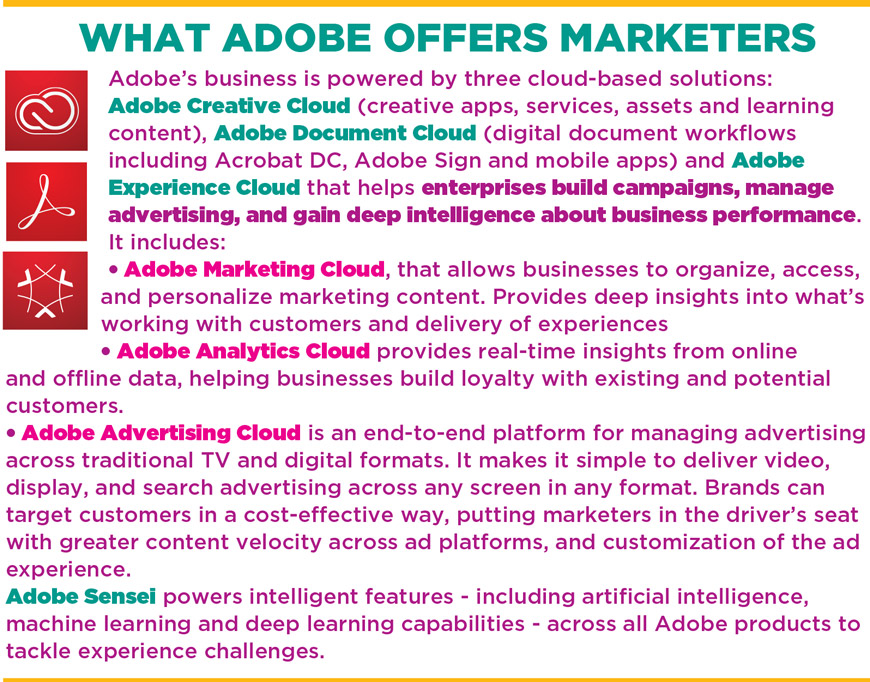
Q] What is your marketing strategy, what are the investments that are going into it, and to market the company’s services in India?
Clearly, digital platforms comprise a significant amount of our efforts, and we are seeing some fantastic results there. So, about 70% of what we do in terms of marketing is digital, and 30% is what we do by way of thought leadership as well as participation in events which are more physical. Overall, the technologies that we apply on our website, our social media platform, participation in flagship events, not to mention our own events, are some of the channels that we have used to reach out to our customers, both to acquire customers as well as upscale and educate the existing customers, and constantly work on retaining them.




